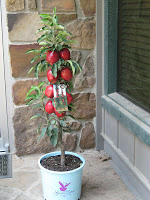Tasty Red™, Tangy Green™, Blushing Delight™ and Golden Treat™ Urban™ Columnar Apples yield good taste in a square foot!
Edible gardening is taking the forefront as the locally-grown food movement gains ground, and more and more gardeners are finding success harvesting their own crops. Enter Urban™ Columnar Apples by Garden Debut®, new introductions that yield great tasting apples in a tiny space. Now it’s easy to produce delicious, full-sized apples on slender, vertical trees that grow in large pots on sunny decks or balconies.
Urban™ Columnar Apple trees are loaded with fruiting spurs along the main leader, and branches are short and upright, producing straight, upright-growing, cylindrical apple trees. Plant Urban™ Columnar Apples in the ground, or transplant to larger containers coordinated with home and architecture and enjoy moving them around as desired.
Romantic apple blossoms in spring will enchant homeowners, apartment dwellers, condo owners, suburbanites and those short on space. Urban™ apple trees mature at 8 to 10 feet tall but less than two feet in diameter(!) , and are extremely healthy and disease resistant. When grown in full sun expect full-sized fruit the first year from planting, so long as there are two or more varieties for cross pollination. As trees mature, the yield of apples will increase. Be sure to maintain fertility levels for good growth and yields.
A choice of four varieties in the Urban™ Columnar Apple Series developed by Dr. Jaroslav Tupy of the Czech Republic ensure a wide selection of flavor, plus good cross-pollination and fruit set:
Tasty Red™ is a bright red apple with a sweet, juicy flavor
Blushing Delight™ produces a blush of reddish green fruit with a slightly sweeter taste
Golden Treat™ greenish-gold apples are tart in early fall, but get sweeter the longer they are on the tree
Tangy Green™ lime green apples add a crisp, tart flavor to the series
Harvest tasty fruit within easy reach of the patio table, or host a pick-your-own on the porch and watch heads turn. Try Urban™ Columnar Apples in large tubs flanking the entrance or plant alongside a border or fence to add value. The impact of a loaded apple tree in a tiny space is irresistible.
Statistics Chart for Urban™ Columnar Apple Series:
Tasty Red(TM) Urban Columnar Apple Malus 'UEB 3449-1'
Blushing Delight(TM) Urban Columnar Apple Malus 'UEB 3727-4'
Golden Treat(TM) Urban Columnar Apple Malus 'UEB3358-3'
Tangy Green(TM) Urban Columnar Apple Malus 'UEB 3812-2'
Plant Category: | Deciduous flowering fruit trees |
Mature Height: | 8 to 10 feet |
Mature Spread: | 1 ½ to 2 feet |
Mature Form: | Extremely narrow, columnar form with multiple fruiting spurs on central leader |
Growth Rate: | Vigorous |
Sun Exposure: | Best grown in full sun |
Soil Type: | Garden loam, amended clay, soil-less potting mixes with good fertility |
Soil Moisture: | Moist, well-drained soils |
Chilling Requirement: | 800 – 1200 hours for good bud set (number of hours the temperature is below 45 degrees F. but above 32 degrees F. ) . |
Flower Color: | Romantic pink and white apple blossoms on bare branches in early spring |
Fruit Set and Yield: | Two varieties are required for cross-pollination and good fruit set: expect full-sized fruit from the first year |
Fruit: | Four varieties of Urban™ Apple Series provide a wide choice of taste and color on full-sized apples: Tasty Red(TM) Urban Columnar Apple Malus 'UEB 3449-1' Blushing Delight(TM) Urban Columnar Apple Malus 'UEB 3727-4' Golden Treat(TM) Urban Columnar Apple Malus 'UEB3358-3' Tangy Green(TM) Urban Columnar Apple Malus 'UEB 3812-2' |
Summer Color: | Apple green leaf color |
Fall Color: | Negligible |
pH Level: | 5.5 – 7.5 |
Zones: | 4 – 9 (-30 degrees F or 23 Degrees C), well suited for most of the continental U.S. |
Heredity: | Developed by Dr. Jaroslav Tupy, Czech Republic |
When performance counts, use Garden Debut® introductions
# # #














 Hope you'll be trying these this spring!
Hope you'll be trying these this spring! 










